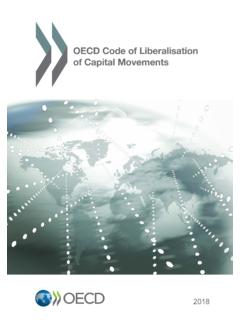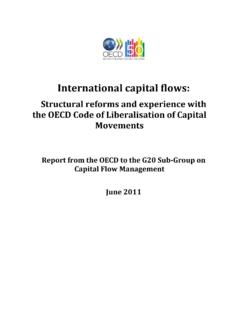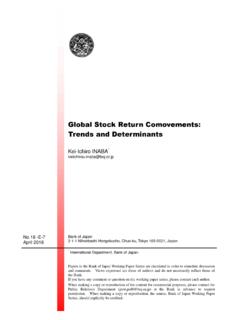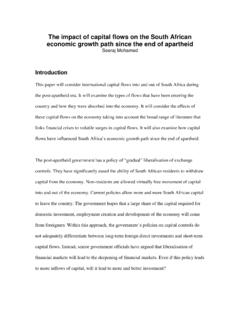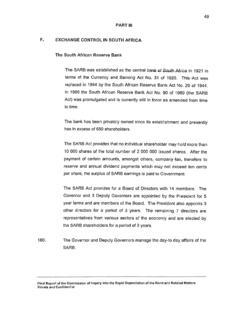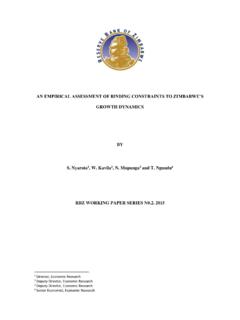Transcription of GROWTH, EMPLOYMENT AND REDISTRIBUTION
1 growth , EMPLOYMENT ANDREDISTRIBUTIONA Macro-Economic Strategy(Appendices) growth , EMPLOYMENT AND REDISTRIBUTIONA MACROECONOMIC STRATEGYList of REVIEW OF ECONOMIC DEVELOPMENT SINCE 1994page INTERPRETATION OF THE RECENT DEPRECIATION page MACROECONOMIC OUTLOOK OF CURRENT POLICIES page MACROECONOMIC OUTLOOK OF THE INTEGRATED STRATEGY page MACROECONOMIC IMPLICATIONS OF A FISCAL EXPANSION page REVIEW OF RECENT FISCAL DEVELOPMENTS page REPRIORITISATION OF EXPENDITURE AND THE RDP FUND page THE PUBLIC SECTOR WAGE BILL page OUTLOOK FOR FISCAL POLICY page EFFECTS OF RECENT TRADE LIBERALISATION page ON TAX INCENTIVES FOR INVESTMENT
2 Page FOREIGN INVESTMENT page ANALYSIS OF LABOUR MARKET TRENDS page PROSPECTS FOR GOVERNMENT EMPLOYMENT page PROSPECTS OF EMPLOYMENT CREATION page OF THE ECONOMIC MODELS page 37 Published by the Department of Finance, Republic of South Africa, Private Bag X115, Pretoria 0001, faxnumber (012) 323 Minister of Finance, Trevor Manuel, the Deputy Finance Minister, Gill Marcus and the ActingDirector General, Maria Ramos, wish to acknowledge the contribution of the technical team comprisingthe following individuals:Andre Roux, coordinator (Development Bank of Southern Africa)Iraj Abedian, coordinator (University of Cape Town)Andrew Donaldson (Department of Finance)Brian Khan (University of Cape Town)Ben Smit (University of Stellendbosch)Daleen Smal (South African Reserve Bank)Alan Hirsch (Department of Trade and Industry)Guy Mhone (Department of Labour)Ernie van der Merwe (South African Reserve Bank)Ian Goldin (Development Bank of Southern Africa)Stephen Gelb (University of Durban-Westville)Dirk van Seventer (Development Bank of Southern Africa)
3 Servaas van der Berg (University of Stellendbosch)Luiz Pereira da Silva (World Bank)Richard Ketley (World Bank)APPENDIX 1A REVIEW OF ECONOMIC DEVELOPMENTS SINCE 1994 Recent Macroeconomic PerformanceThe growth performance of the South African economy has improved considerably over the past twoyears. Following three years of economic decline, real gross domestic product rose by 1,3 percent in1993, 2,7 percent in 1994 and 3,3 percent in 1995. This stronger growth occurred in all secondary andtertiary sectors, although agriculture and mining experienced declines in marked increase in real fixed investment has been a welcome feature of the upswing.
4 Privateconsumption expenditure also firmed as incomes rose and consumer confidence improved. In contrast,real government consumption expenditure, which increased sharply until 1994, levelled off in volumes stagnated in 1994 and then rose by an impressive 8 percent in 1995, while real importshave increased at an annual rate of 16 percent since in 1995 declined to levels last seen in the early 1970s. The annual rate of increase in consumerprices has been below 10 percent for three years. Positive real interest rates and containment of moneysupply growth have been important factors in combating sector EMPLOYMENT has responded sluggishly to the economic recovery.
5 Formal non-agriculturalemployment declined throughout the period 1989 to 1994 and appears to have increased by little morethan 50 000 during 1995. However, EMPLOYMENT in unregulated sectors of the labour market appears tobe on an upward post-election period has seen considerable movement in the balance of payments. A net capitalinflow amounting to R31 billion was recorded between mid-1994 and the end of 1995. The bulk of thisinflow has been portfolio investment, which is comparatively mobile and sensitive to shifts in marketperceptions.
6 The balance on current account moved into deficit over this period as imports, particularlycapital goods, rose mid-February the foreign exchange market has been subjected to intense speculative pressure,causing a substantial real depreciation of the rand. This development to some extent reflects that therand had become somewhat overvalued in response to a temporary capital surge, but was also the resultof increased uncertainty regarding policy trends and economic PolicyIn response to the unsustainable fiscal situation that had developed by 1992/93, when the overall deficitreached 9,0 percent of GDP, fiscal policy has been informed by the following goals: to cut the overall budget deficit and the level of government dissaving; to avoid permanent increases in the overall tax burden.
7 To reduce general government consumption expenditure relative to GDP; and to strengthen the general government contribution to gross domestic fixed government dissaving has not yet been eliminated, progress has been made in this cash-flow adjusted exchequer deficit was reduced to an estimated 5,4 percent in 1995 general government tax revenue has increased from 25,6 percent to 26,8 percent of GDPbetween 1992/93 and 1994/95, but still somewhat below the 1989/90 level of 27,1 percent. At the sametime, significant shifts in the allocation of expenditure have been effected in accordance withreconstruction and development improved discipline in fiscal policy has contributed to greater financial stability and lower has also enhanced local and international business confidence, contributing to capital inflows andinvestment.
8 A gradual approach to deficit reduction has been necessary to prevent disruptions in theprovision of essential public services, but has also had the advantage of avoiding a major contraction inaggregate is widely acknowledged that the overall tax burden is high and that personal income tax rates, inparticular, lead to excessive distortions in business and household behaviour. A range of tax reformshave been implemented over the past two issues and fiscal relations between the different tiers of government are subjects of majorinvestigations, finalisation of which should lead to greater fiscal certainty and business confidence.
9 Theongoing reform of the budgetary process introduced by the Department of State Expenditure willcontribute to more effective planning and expenditure and Monetary PolicyThe basic objective of monetary policy has been to protect the value of the rand. The Reserve Bankoperates within a framework in which effective control over the money supply serves as an intermediateobjective. Annual guidelines for growth in broadly defined monetary aggregates are set, aimed atreducing the inflation a period of negative real interest rates in 1986/87, monetary policy has been kept relativelytight.
10 A consistent anti-inflationary stance was maintained throughout the 1989-1993 cyclical downturn,bringing broad money supply growth down from 28 percent to single-digit levels. The lower rates ofincrease in monetary aggregates, with sustained surpluses on the current account, enabled nominalinterest rates to decline. The Bank rate was reduced in steps from a maximum of 18 percent in 1989 to alow point of 12 percent in late acceleration in money supply and credit growth in 1994 called for tighter policies to prevent aresurgence of inflation.










